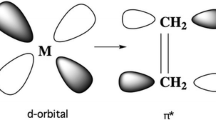Abstract
The electronic structure of several phospha-alkenes has been studied by the MNDO method. The frontier orbitals (occupied and unoccupied) of these compounds are of the π type. The conjugation effects have a significant influence on their energy and structure, as well as on the intramolecular distribution of the electron density. The results of the calculations are consistent with the available experimental data. The MNDO method makes it possible to predict the possible paths for the chemical conversion of phospha-alkenes in reactions with charge and orbital control.
Similar content being viewed by others
Literature cited
I. E. Boldeskul, V. V. Pen'kovskii, and M. I. Povolotskii, “Distribution of the electron density and internal rotation in phospha-alkenes according to data from quantum-chemical calculations by the MNDO method,” Teor. Éksp. Khim.,23, No. 6, 734–736 (1987).
H. Bock and M. Bankmann, “H3C-P=CH2: ein Ylid mit zweifach koordiniertem Phosphor?,” Angew. Chem.,98, No. 3, 287–288 (1986).
D. Gudat, E. Niecke, W. Sachs, and P. Rademacher, “Zur Elektronenstruktur von Phosphor(III)-p-π-Bindungssystemen: UV- and PE-specktroskopische Untersuchungen an Methylenphosphanen vom Typ R-P=C(SiMe3)2,” Z. Anorg. Allgem. Chem.,545, 7–23 (1987).
V. V. Zverev, “Energy and composition of the highest occupied orbitals of derivatives of three-coordinate phosphorus,” Zh. Obshch. Khim.,54, No. 5, 1060–1068 (1984).
C. Thomson, “Electronic structure of phospha-alkenes,” J. Chem. Soc. Chem. Commun., No. 9, 522–523 (1977).
P. J. Bruna, V. Krumbach, and S. D. Peyerimhoff, “Vertical electron spectra of the isovalent molecules H2CNH, H2SiNH, H2CPH, and H2SiPH on the basis of MRD-CI calculations,” Can. J. Chem.,63, No. 7, 1594–1608 (1985).
L. V. Gurvich, G. V. Karachevtsev, V. N. Kondrat'ev, et al., Bond Energies, Ionization Potentials, and Electron Affinity [in Russian], Nauka, Moscow (1974).
B. G. Zykov, “Evaluations of the σ-π conduction, inductive effect, and pπdπ interaction in organosilicon derivatives of ethylene and furan,” Izv. Akad. Nauk SSSR, Ser. Khim., No. 10, 2230–2235 (1986).
A. N. Chernega, M. Yu. Antipin, Yu. T. Struchkov, et al., “Spatial structure of alkylidenephosphines. X-ray structural investigation of C,C-bis(dimethylamino)methylenephosphine,” Zh. Strukt. Khim.,27, No. 5, 78–82 (1986).
A. N. Chernega, M. Yu. Antipin, and Yu. T. Struchkov, “Molecular structure of compounds of two-coordinate phosphorus,” ibid.,29, No. 2, 122–164 (1988).
I. I. Patsanovskii (Patsanovsky), J. Z. Stepanova, E. A. Ishmaeva, et al., “Polarity and conjugative effects with participation of P=C and P=N double bonds in PII compounds,” in: First International Conference on Heteroatomic Chemistry: Abstracts, Kobe, Japan, July 19–24, 1987, Krobe (1987), p. 76.
V. V. Pen'kovskii and I. E. Boldeskul, “Quantum-chemical study of intramolecular electronic effects in phospha-alkenes,” Teor. Éksp. Khim.,22, No. 5, 545–553 (1986).
V. V. Pen'kovskii and I. E. Boldeskul, “Quantum-chemical study of the protonation of aminophospha-alkenes,” ibid.,25, No. 3, 545–553 (1989).
L. N. Markovskii, V. D. Romanenko, and A. V. Ruban, Chemistry of Acyclic Compounds of Two-Coordinate Phosphorus [in Russian], Naukova Dumka, Kiev (1988).
G. Klopman, “The generalized perturbation theory of chemical reactivity and its applications,” in: G. Klopman (editor), Chemical Reactivity and Reaction Paths, Wiley, New York (1974), Chap. 4, pp. 55–165.
Author information
Authors and Affiliations
Additional information
Translated from Teoreticheskaya i Éksperimental'naya Khimiya, Vol. 25, No. 2, pp. 143–149, March–April, 1989.
Rights and permissions
About this article
Cite this article
Pen'kovskii, V.V., Boldeskul, I.E. Electronic structure and properties of the reaction centers of phospha-alkenes in the MNDO approximation. Theor Exp Chem 25, 128–133 (1989). https://doi.org/10.1007/BF01135000
Received:
Issue Date:
DOI: https://doi.org/10.1007/BF01135000



